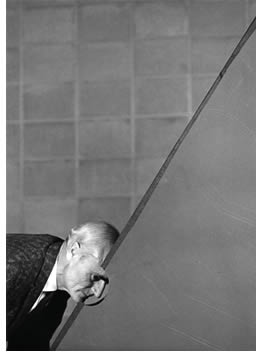Throughout much of the 20th century, most of the world was blissfully unaware that algebraists were scheming to elbow geometers out of the mathematical equation. At an education conference in 1959, during the peak of the anti-geometry movement, French mathematician Jean Dieudonné notoriously screamed, “Down with Euclid! Death to triangles!”
But a battered geometry was eventually revived, thanks in large part to Donald Coxeter (LLD 1979). A professor of geometry at U of T for more than 60 years, he is the subject of the recent book King of Infinite Space: Donald Coxeter, the Man Who Saved Geometry, by Siobhan Roberts.
When Coxeter received his first posting at U of T in 1936, he was already an expert in polytopes, a type of shape that resides in multiple dimensions. He became interested in reflections and symmetries, and he invented geometric tools (called Coxeter groups, Coxeter numbers and Coxeter diagrams) that broadened and deepened the study of symmetry in both geometry and algebra. Coxeter also wrote two influential books, Regular Polytopes and Regular Complex Polytopes, which, according to Roberts, are widely considered the sequels to Euclid’s Elements. And it wasn’t just Coxeter’s academic contributions that revived an ailing discipline. “He was so passionate about the beautiful and elegant gems of classic geometry that he just kept propagating his passion like an apostle,” explains Roberts.
Roberts is currently developing a documentary film about Coxeter for TVO and the National Film Board. In 2002, she filmed Coxeter in Budapest, Hungary, at the last geometry conference he attended. She also interviewed mathematicians from around the world during the Coxeter Legacy Conference at U of T in 2004, the year after Coxeter’s death at age 96. Roberts says it was Coxeter’s unique appeal that propelled her into both projects: “When I met Coxeter he was 94, but he still had an intellectual charisma about him.”
After reading Coxeter’s diaries (which he kept for more than 75 years), Roberts was also charmed by his eccentricities. He was hopelessly awkward with romantic matters and proposed to his wife, Rien, in a graveyard. To “get the juices flowing,” he stood on his head every morning before breakfast. “He thought about geometry every waking hour, in the bath and while driving…and even while napping or sleeping, which he said was the best time for a breakthrough, when the brain is at rest,” says Roberts.
The practical applications of Coxeter’s geometry are far-reaching. According to Roberts, Coxeter’s investigations into symmetries have touched almost every area of mathematics and science that involves patterns, including the data-mining technology behind Amazon.com and anti-terrorism programs. And if the geometry of protein folding is figured out – proteins play a central role in body chemistry – Coxeter’s geometry could one day contribute to medical breakthroughs in Alzheimer’s disease, cancer and AIDS.
But for Roberts, Coxeter’s passion is reason enough to care about his work. “His legacy,” she says, “might be in demonstrating… faith in intuition and imagination and wandering exploration just for curiosity’s sake.”
Recent Posts
People Worry That AI Will Replace Workers. But It Could Make Some More Productive
These scholars say artificial intelligence could help reduce income inequality
A Sentinel for Global Health
AI is promising a better – and faster – way to monitor the world for emerging medical threats
The Age of Deception
AI is generating a disinformation arms race. The window to stop it may be closing





